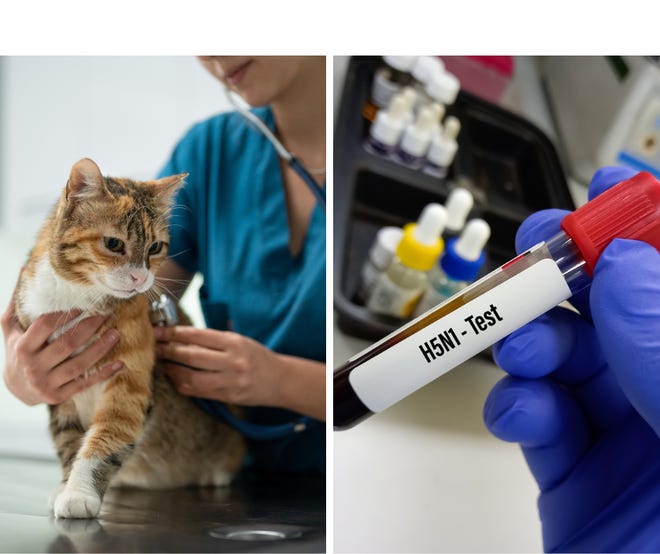A worrisome avian influenza outbreak has spread rapidly in the United States, infecting four humans so far, affecting dozens of species and infecting mammals in at least 31 states.
Among the infected animals are cattle, foxes, rats, skunks, mountain lions, harbor seals and alpacas in 12 states.
At least 21 pet cats in nine states have been infected with the virus since March 1. United States Department of AgricultureThe cats that have tested positive include stray cats, barn cats and household pets.
It is possible for humans to get the disease from pets, but the chances are low. CDC saysThe H5N1 virus can be spread through cat saliva, feces and other bodily fluids. All of the infected people were infected on the farm, but have made full recoveries and authorities are working to contain the spread.
Here’s what you need to know:
Virus spread:‘Giant’ avian flu outbreaks surge in U.S. dairy herds, raising concerns
Can cats get bird flu?
The short answer is: Yes, cats can catch avian flu if they come into contact with an infected bird.
Avian influenza is thought to be primarily a risk between wild and domestic birds, with a recent outbreak of avian influenza in dairy cattle thought to be the first of its kind.
Cornell University researchers believe that Texas dairy cows became infected through contaminated water or food as birds migrated through the area, and then the cows likely contracted the virus from close proximity to each other.
Dr. Elisha Frye, an assistant professor of practice in the Department of Population Medicine and Diagnostic Sciences at Cornell University, was called to the affected dairy farm in March to investigate the deaths of the cows, birds, and cats on the property. Dr. Frye used milk samples, feces, and nasal swabs to detect the presence of the disease in the cows.
Tests were also carried out on the dead birds found on the farm, as well as one of three cats found dead on the property around the same time – all of which found evidence of avian influenza.
“It was around the same time that we found it in the cow samples, and there was some connection,” Fry previously told USA Today. “Having the same pathogen in chicken, cat and cow milk made sense to us at the time that it was the primary cause of disease.”
Have cats ever had bird flu before?
of CDC has records of sporadic mammalian outbreaks Previous bird flu outbreaks have affected wild animals such as foxes and bears, as well as pets such as dogs and cats, and authorities believe these cases were caused by the animals eating infected birds or poultry.
In 2004, Occurrence in livestock In Thailand, infections have been reported in pets, including cats and dogs, and Germany and North America in 2006The group says transmission of the virus from pets to humans is very rare and unlikely, but has occurred as a result of prolonged, unprotected contact.
In 2016, a New York City veterinarian infected with bird flu Repeated exposure to sick cats without protective gear left the vet suffering from mild flu symptoms.

Signs your pet may be sick
The chances of a cat catching bird flu are very small, but it can become infected if your cat is often outdoors and eats infected birds, has close contact with infected birds, or is in a contaminated environment.
If people or animals in your home are suspected to have been near a sick or dead bird, they should be monitored. Watch for the following signs:
- Fever or feeling feverish/chills
- cough
- sore throat
- Difficulty breathing/shortness of breath
- Conjunctivitis (watery, red, inflamed, discharge from the eyes)
- headache
- Runny or stuffy nose
- Muscle and body pain
- diarrhea

How to prevent the spread of bird flu
The most effective way to prevent the spread of infection is to avoid contact in the first place. The CDC says:
- Avoid direct contact with wild birds and observe them from a distance whenever possible.
- Avoid contact between pets (pet birds, dogs, cats, etc.) and wild birds
- Do not touch surfaces or water sources (such as ponds, waterers, buckets, pots, troughs, etc.) that may be contaminated with sick or dead birds, their droppings or litter, saliva, feces, or other bodily fluids without wearing personal protective equipment (PPE).
- Avoid touching your mouth, nose, or eyes after coming into contact with birds or surfaces that may be contaminated with wild or domestic bird saliva, mucus, or excrement.
- Wash your hands with soap and water after touching birds or other sick animals.
- Change clothing after contact with wild birds, poultry, or sick animals.
Contributor: Dina Boyles Pulver, USA TODAY

